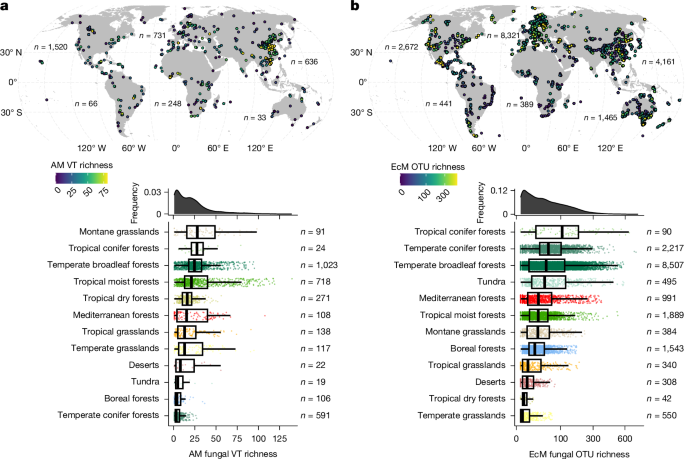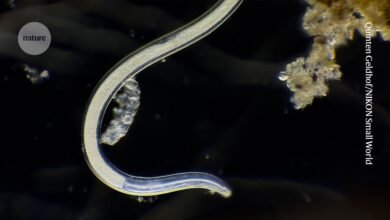Global hotspots of mycorrhizal fungal richness are poorly protected

Högberg, M. N. & Högberg, P. Extramatrical ectomycorrhizal mycelium contributes one-third of microbial biomass and produces, together with associated roots, half the dissolved organic carbon in a forest soil. New Phytol. 154, 791–795 (2002).
van Der Heijden, M. G., Martin, F. M., Selosse, M. A. & Sanders, I. R. Mycorrhizal ecology and evolution: the past, the present, and the future. New Phytol. 205, 1406–1423 (2015).
Hawkins, H. J. et al. Mycorrhizal mycelium as a global carbon pool. Curr. Biol. 33, R560–R573 (2023).
Cavicchioli, R. et al. Scientists’ warning to humanity: microorganisms and climate change. Nat. Rev. Microbiol. 17, 569–586 (2019).
Guerra, C. A. et al. Tracking, targeting, and conserving soil biodiversity. Science 371, 239–241 (2021).
Větrovský, T. et al. GlobalFungi, a global database of fungal occurrences from high-throughput-sequencing metabarcoding studies. Sci. Data 7, 228 (2020).
Tedersoo, L. et al. The Global Soil Mycobiome consortium dataset for boosting fungal diversity research. Fungal Divers. 111, 573–588 (2021).
Větrovský, T. et al. GlobalAMFungi: a global database of arbuscular mycorrhizal fungal occurrences from high‐throughput sequencing metabarcoding studies. New Phytol. 240, 2151–2163 (2023).
Frey, S. D. Mycorrhizal fungi as mediators of soil organic matter dynamics. Annu. Rev. Ecol. Evol. Syst. 50, 237–259 (2019).
Tedersoo, L. & Bahram, M. Mycorrhizal types differ in ecophysiology and alter plant nutrition and soil processes. Biol. Rev. 94, 1857–1880 (2019).
Brundrett, M. C. & Tedersoo, L. Evolutionary history of mycorrhizal symbioses and global host plant diversity. New Phytol. 220, 1108–1115 (2018).
Crowther, T. W. et al. The global soil community and its influence on biogeochemistry. Science 365, eaav0550 (2019).
Steidinger, B. S. et al. Climatic controls of decomposition drive the global biogeography of forest-tree symbioses. Nature 569, 404–408 (2019).
Soudzilovskaia, N. A. et al. Global mycorrhizal plant distribution linked to terrestrial carbon stocks. Nat. Commun. 10, 5077 (2019).
Kivlin, S. N., Hawkes, C. V. & Treseder, K. K. Global diversity and distribution of arbuscular mycorrhizal fungi. Soil Biol. Biochem. 43, 2294–2303 (2011).
Tedersoo, L. et al. Global diversity and geography of soil fungi. Science 346, 1256688 (2014).
Větrovský, T. et al. A meta-analysis of global fungal distribution reveals climate-driven patterns. Nat. Commun. 10, 5142 (2019).
Guerra, C. A. et al. Global hotspots for soil nature conservation. Nature 610, 693–698 (2022).
Tedersoo, L. et al. Global patterns in endemicity and vulnerability of soil fungi. Global Change Biol. 28, 6696–6710 (2022).
Cameron, E. K. et al. Global mismatches in aboveground and belowground biodiversity. Conserv. Biol. 33, 1187–1192 (2019).
Meyer, H. & Pebesma, E. Machine learning-based global maps of ecological variables and the challenge of assessing them. Nat. Commun. 13, 2208 (2022).
Jansen, J. et al. Stop ignoring map uncertainty in biodiversity science and conservation policy. Nat. Ecol. Evol. 6, 828–829 (2022).
Albuquerque, F., Astudillo-Scalia, Y., Loyola, R. & Beier, P. Towards an understanding of the drivers of broad-scale patterns of rarity-weighted richness for vertebrates. Biodivers. Conserv. 28, 3733–3747 (2019).
Kinlock, N. L. et al. Explaining global variation in the latitudinal diversity gradient: meta‐analysis confirms known patterns and uncovers new ones. Global Ecol. Biogeogr. 27, 125–141 (2018).
Sabatini, F. M. et al. Global patterns of vascular plant alpha diversity. Nat. Commun. 13, 4683 (2022).
Toussaint, A. et al. Asymmetric patterns of global diversity among plants and mycorrhizal fungi. J. Veg. Sci. 31, 355–366 (2020).
Kokkoris, V. et al. Codependency between plant and arbuscular mycorrhizal fungal communities: what is the evidence? New Phytol. 228, 828–838 (2020).
Read, D. J. Mycorrhizas in ecosystems. Experientia 47, 376–391 (1991).
Phillips, R. P., Brzostek, E. & Midgley, M. G. The mycorrhizal‐associated nutrient economy: a new framework for predicting carbon–nutrient couplings in temperate forests. New Phytol. 199, 41–51 (2013).
Jung, M. et al. Areas of global importance for conserving terrestrial biodiversity, carbon and water. Nat. Ecol. Evol. 5, 1499–1509 (2021).
Jenkins, C. N., Pimm, S. L. & Joppa, L. N. Global patterns of terrestrial vertebrate diversity and conservation. Proc. Natl Acad. Sci. USA 110, E2602–E2610 (2013).
Kass, J. M. et al. The global distribution of known and undiscovered ant biodiversity. Sci. Adv. 8, eabp9908 (2022).
Chen, C. et al. China and India lead in greening of the world through land-use management. Nat. Sustain. 2, 122–129 (2019).
Tedersoo, L. in Biogeography of Mycorrhizal Symbiosis Vol. 230 (ed. Tedersoo, L.) 469–531 (Springer, 2017).
Bingham, H. C. et al. Sixty years of tracking conservation progress using the World Database on Protected Areas. Nat. Ecol. Evol. 3, 737–743 (2019).
Joppa, L. N. & Pfaff, A. High and far: biases in the location of protected areas. PLoS ONE 4, e8273 (2009).
van den Hoogen, J., van Nuland, M. & Kumar, S. Data and code for: Global Hotspots of Mycorrhizal Fungal Richness are Poorly Protected. Zenodo https://doi.org/10.5281/zenodo.14871588 (2025).
Lundberg, S. M. et al. From local explanations to global understanding with explainable AI for trees. Nat. Mach. Intell. 2, 56–67 (2020).
Mikryukov, V. et al. Connecting the multiple dimensions of global soil fungal diversity. Sci. Adv. 9, eadj8016 (2023).
Averill, C., Turner, B. L. & Finzi, A. C. Mycorrhiza-mediated competition between plants and decomposers drives soil carbon storage. Nature 505, 543–545 (2014).
Hicks Pries, C. E. et al. Differences in soil organic matter between EcM‐and AM‐dominated forests depend on tree and fungal identity. Ecology 104, e3929 (2023).
Davison, J. et al. Temperature and pH define the realised niche space of arbuscular mycorrhizal fungi. New Phytol. 231, 763–776 (2021).
Kennedy, C. M., Oakleaf, J. R., Theobald, D. M., Baruch-Mordo, S. & Kiesecker, J. Managing the middle: a shift in conservation priorities based on the global human modification gradient. Glob. Change Biol. 25, 811–826 (2019).
Chaudhary, V. B., Nolimal, S., Sosa‐Hernández, M. A., Egan, C. & Kastens, J. Trait‐based aerial dispersal of arbuscular mycorrhizal fungi. New Phytol. 228, 238–252 (2020).
Guerra, C. A. et al. Global projections of the soil microbiome in the Anthropocene. Global Ecol. Biogeogr. 30, 987–999 (2021b).
Guzman, A. et al. Crop diversity enriches arbuscular mycorrhizal fungal communities in an intensive agricultural landscape. New Phytol. 231, 447–459 (2021).
Lang, N., Jetz, W., Schindler, K. & Wegner, J. D. A high-resolution canopy height model of the Earth. Nat. Ecol. Evol. 7, 1778–1789 (2023).
Barron, E. Conservation of abundance: How fungi can contribute to rethinking conservation. Conserv. Soc. 21, 99–109 (2023).
Guerra, C. A. et al. Blind spots in global soil biodiversity and ecosystem function research. Nat. Commun. 11, 3870 (2020).
Senior, R. A. et al. Global shortfalls in documented actions to conserve biodiversity. Nature 630, 387–391 (2024).
Labouyrie, M. et al. Patterns in soil microbial diversity across Europe. Nat. Commun. 14, 3311 (2023).
Averill, C. et al. Defending Earth’s terrestrial microbiome. Nat. Microbiol. 7, 1717–1725 (2022).
Fleischman, F. et al. Restoration prioritization must be informed by marginalized people. Nature 607, E5–E6 (2022).
Langhammer, P. F. et al. The positive impact of conservation action. Science 384, 453–458 (2024).
Lutz, S. et al. Global richness of arbuscular mycorrhizal fungi. Fungal Ecol. 74, 101407 (2025).
Tedersoo, L. & Lindahl, B. Fungal identification biases in microbiome projects. Environ. Microbiol. Rep. 8, 774–779 (2016).
Yang, R. H. et al. Evaluation of the ribosomal DNA internal transcribed spacer (ITS), specifically ITS1 and ITS2, for the analysis of fungal diversity by deep sequencing. PLoS ONE 13, 206428 (2018).
Bengtsson‐Palme, J. et al. Improved software detection and extraction of ITS1 and ITS 2 from ribosomal ITS sequences of fungi and other eukaryotes for analysis of environmental sequencing data. Methods Ecol. Evol. 4, 914–919 (2013).
Edgar, R. C. UPARSE: highly accurate OTU sequences from microbial amplicon reads. Nat. Methods 10, 996–998 (2013).
Põlme, S. et al. FungalTraits: a user-friendly traits database of fungi and fungus-like stramenopiles. Fungal Divers. 105, 1–16 (2020).
Öpik, M. et al. The online database MaarjAM reveals global and ecosystemic distribution patterns in arbuscular mycorrhizal fungi (Glomeromycota). New Phytol. 188, 223–241 (2010).
Bruns, T. D. & Taylor, J. W. Comment on “Global assessment of arbuscular mycorrhizal fungus diversity reveals very low endemism”. Science 351, 826–826 (2016).
Chao, A. et al. Rarefaction and extrapolation with Hill numbers: a framework for sampling and estimation in species diversity studies. Ecol. Monogr. 84, 45–67 (2014).
Hsieh, T. C., Ma, K. H. & Chao, A. iNEXT: an R package for rarefaction and extrapolation of species diversity (Hill numbers). Methods Ecol. Evol. 7, 1451–1456 (2016).
Bissett, A. et al. Introducing BASE: the Biomes of Australian Soil Environments soil microbial diversity database. GigaScience 5, s13742-016 (2016).
Yan, D. et al. High-throughput eDNA monitoring of fungi to track functional recovery in ecological restoration. Biol. Conserv. 217, 113–120 (2018).
Usher, M. B. in Wildlife Conservation Evaluation (ed. Usher, M. B.) 3–44 (Chapman & Hall, 1986).
Albuquerque, F. & Beier, P. Predicted rarity‐weighted richness, a new tool to prioritize sites for species representation. Ecol. Evol. 6, 8107–8114 (2016).
van den Hoogen, J. et al. Soil nematode abundance and functional group composition at a global scale. Nature 572, 194–198 (2019).
van den Hoogen, J. et al. A global database of soil nematode abundance and functional group composition. Sci. Data 7, 103 (2020).
Hengl, T. et al. SoilGrids250m: global gridded soil information based on machine learning. PLoS ONE 12, e0169748 (2017).
Karger, D. N. et al. Climatologies at high resolution for the earth’s land surface areas. Sci. Data 4, 170122 (2017).
Herrando-Moraira, S. et al. Climate Stability Index maps, a global high resolution cartography of climate stability from Pliocene to 2100. Sci. Data 9, 48 (2022).
Ruesch, A. & Gibbs, H. K. New IPCC Tier-1 global biomass carbon map for the year 2000. ESS-DIVE https://doi.org/10.15485/1463800 (2008).
Tuanmu, M. N. & Jetz, W. A global 1‐km consensus land‐cover product for biodiversity and ecosystem modelling. Global Ecol. Biogeogr. 23, 1031–1045 (2014).
Tuanmu, M. N. & Jetz, W. A global, remote sensing‐based characterization of terrestrial habitat heterogeneity for biodiversity and ecosystem modelling. Global Ecol. Biogeogr. 24, 1329–1339 (2015).
Cai, L. et al. Global models and predictions of plant diversity based on advanced machine learning techniques. New Phytol. 237, 1432–1445 (2023).
Trabucco, A. & Zomer, R. J. Global aridity index and potential evapo-transpiration (ET0) climate database v2. figshare https://doi.org/10.6084/m9.figshare.7504448.v3 (2019).
Dinerstein, E. et al. An ecoregion-based approach to protecting half the terrestrial realm. BioScience 67, 534–545 (2017).
Ploton, P. et al. Spatial validation reveals poor predictive performance of large-scale ecological mapping models. Nat. Commun. 11, 4540 (2020).
Wadoux, A. M. C., Heuvelink, G. B., De Bruin, S. & Brus, D. J. Spatial cross-validation is not the right way to evaluate map accuracy. Ecol. Modell. 457, 109692 (2021).
Meyer, H. & Pebesma, E. Predicting into unknown space? Estimating the area of applicability of spatial prediction models. Methods Ecol. Evol. 12, 1620–1633 (2021).
Milà, C., Mateu, J., Pebesma, E. & Meyer, H. Nearest neighbour distance matching leave‐one‐out cross‐validation for map validation. Methods Ecol. Evol. 13, 1304–1316 (2022).
Linnenbrink, J., Milà, C., Ludwig, M. & Meyer, H. kNNDM CV: k-fold nearest-neighbour distance matching cross-validation for map accuracy estimation. Geosci. Model Dev. 17, 5897–5912 (2024).
Phillips, H. R. et al. Global distribution of earthworm diversity. Science 366, 480–485 (2019).
Potapov, A. M. et al. Globally invariant metabolism but density–diversity mismatch in springtails. Nat. Commun. 14, 674 (2023).
Hiemstra, P. H., Pebesma, E. J., Twenhöfel, C. J. & Heuvelink, G. B. Real-time automatic interpolation of ambient gamma dose rates from the Dutch radioactivity monitoring network. Comput. Geosci. 35, 1711–1721 (2009).
Parry J. sfdep: Spatial Dependence for Simple Features. R package version 0.2.3 https://CRAN.R-project.org/package=sfdep (2023).
Dormann, C. F. et al. Methods to account for spatial autocorrelation in the analysis of species distributional data: A review. Ecography 30, 609–628 (2007).
Dray S. et al. adespatial: Multivariate Multiscale Spatial Analysis. R package version 0.3-21 https://CRAN.R-project.org/package=adespatial (2023).
Borcard, D., Gillet, F. & Legendre, P. Numerical Ecology with R (Springer, 2018).
Zhu, K., Woodall, C. W. & Clark, J. S. Failure to migrate: lack of tree range expansion in response to climate change. Glob. Change Biol. 18, 1042–1052 (2012).
Wickham, H. et al. Welcome to the Tidyverse. J. Open Source Softw. 4, 1686 (2019).
Liang, J. et al. Co-limitation towards lower latitudes shapes global forest diversity gradients. Nat. Ecol. Evol. 6, 1423–1437 (2022).
The IUCN Red List of Threatened Species Version 2022-2 (IUCN, 2022); https://www.iucnredlist.org.





